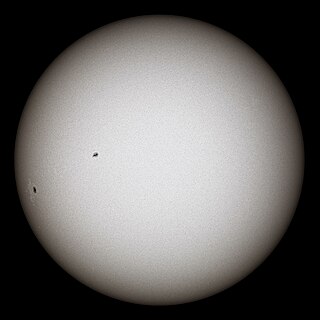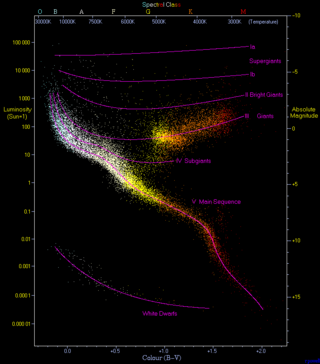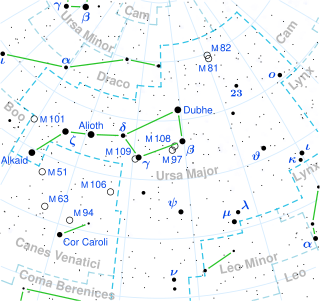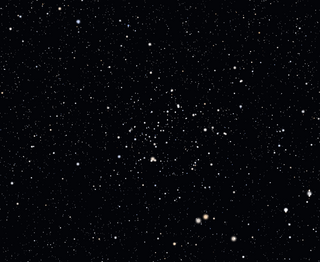In astronomy, absolute magnitude is a measure of the luminosity of a celestial object on an inverse logarithmic astronomical magnitude scale; the more luminous an object, the lower its magnitude number. An object's absolute magnitude is defined to be equal to the apparent magnitude that the object would have if it were viewed from a distance of exactly 10 parsecs, without extinction of its light due to absorption by interstellar matter and cosmic dust. By hypothetically placing all objects at a standard reference distance from the observer, their luminosities can be directly compared among each other on a magnitude scale. For Solar System bodies that shine in reflected light, a different definition of absolute magnitude (H) is used, based on a standard reference distance of one astronomical unit.

Parallax is a displacement or difference in the apparent position of an object viewed along two different lines of sight and is measured by the angle or half-angle of inclination between those two lines. Due to foreshortening, nearby objects show a larger parallax than farther objects, so parallax can be used to determine distances.

Luminosity is an absolute measure of radiated electromagnetic energy per unit time, and is synonymous with the radiant power emitted by a light-emitting object. In astronomy, luminosity is the total amount of electromagnetic energy emitted per unit of time by a star, galaxy, or other astronomical objects.

A visual binary is a gravitationally bound binary star system that can be resolved into two stars. These stars are estimated, via Kepler's third law, to have periods ranging from a few years to thousands of years. A visual binary consists of two stars, usually of a different brightness. Because of this, the brighter star is called the primary and the fainter one is called the companion. If the primary is too bright, relative to the companion, this can cause a glare making it difficult to resolve the two components. However, it is possible to resolve the system if observations of the brighter star show it to wobble about a centre of mass. In general, a visual binary can be resolved into two stars with a telescope if their centres are separated by a value greater than or equal to one arcsecond, but with modern professional telescopes, interferometry, or space-based equipment, stars can be resolved at closer distances.

Beta Centauri is a triple star system in the southern constellation of Centaurus. It is officially called Hadar. The Bayer designation of Beta Centauri is Latinised from β Centauri, and abbreviated Beta Cen or β Cen. The system's combined apparent visual magnitude of 0.61 makes it the second-brightest object in Centaurus and the eleventh brightest star in the night sky. According to dynamical parallax measurements, the distance to this system is about 361 light-years.

Deneb is a first-magnitude blue supergiant star in the constellation of Cygnus. Deneb is one of the vertices of the asterism known as the Summer Triangle and the "head" of the Northern Cross. It is the brightest star in Cygnus and the 19th brightest star in the night sky, with an average apparent magnitude of +1.25.

The cosmic distance ladder is the succession of methods by which astronomers determine the distances to celestial objects. A direct distance measurement of an astronomical object is possible only for those objects that are "close enough" to Earth. The techniques for determining distances to more distant objects are all based on various measured correlations between methods that work at close distances and methods that work at larger distances. Several methods rely on a standard candle, which is an astronomical object that has a known luminosity.

In astronomy, magnitude is a measure of the brightness of an object, usually in a defined passband. An imprecise but systematic determination of the magnitude of objects was introduced in ancient times by Hipparchus.

Alpha Tucanae is a binary star system in the southern circumpolar constellation of Tucana. With an apparent visual magnitude of 2.86, it can be seen with the naked eye from the southern hemisphere. Using parallax measurements, the distance to this system can be estimated as 184 light-years. A cool star with a surface temperature of 4300 K, it is 424 times as luminous as the sun and 37 times its diameter. It is 2.5 to 3 times as massive. It is unclear what stage of evolution the star is in.

Upsilon Orionis (υ Ori, υ Orionis) is a star in the constellation Orion. It has the traditional name Thabit or Tabit (ﺛﺎﺑﺖ, Arabic for "the endurer"), a name shared with Pi3 Orionis. It is a blue-white main sequence star of apparent magnitude 4.62 located over 1,300 light-years distant from the Solar System. It is a suspected Beta Cephei variable.
Photometric parallax is a means to infer the distances of stars using their colours and apparent brightnesses. It was used by the Sloan Digital Sky Survey to discover the Virgo super star cluster.
HD 895 is a multiple star system in the constellation Andromeda. Its apparent magnitude is 6.277, so it can be seen by the naked eye under very favourable conditions. Based on parallax measured by Hipparcos, the system is located around 54 parsecs (180 ly) away, and it is made of two different spectroscopic binary pairs.

The Hertzsprung–Russell diagram is a scatter plot of stars showing the relationship between the stars' absolute magnitudes or luminosities and their stellar classifications or effective temperatures. The diagram was created independently in 1911 by Ejnar Hertzsprung and by Henry Norris Russell in 1913, and represented a major step towards an understanding of stellar evolution.

ξ Cygni is a spectroscopic binary star in the constellation Cygnus, made up of a K-type supergiant star (primary) and an A-type star (secondary). Its apparent magnitude is 3.73, making it readily visible to the naked eye, and it is located around 350 parsecs (1,100 ly) away.
LSS 4067, also known as CD−38°11748, is an O-type blue supergiant star located in the constellation Scorpius, very close to the galactic plane. It is part of the open cluster HM 1, although its distance is not well known; it may be anywhere between 9,500 and 12,700 light years away from the Earth. Despite being a blue supergiant, it is extremely reddened by interstellar extinction, so its apparent magnitude is brighter for longer-wavelength passbands. Without the extinction, it is estimated that LS 4067 would be 5.8 magnitudes brighter, a naked eye star with an apparent magnitude of 5.3.
HD 108063 is a star that lies approximately 176 light-years away in the constellation of Centaurus. The star is not particularly noteworthy with exception to its enormously high heavy element content.
36 Tauri is a binary star in the constellation of Taurus. Parallax measurements made by the Hipparcos spacecraft put it at a distance of over 1,000 light years from Earth. The combined apparent magnitude of the system is about 5.5, meaning it can barely be seen with the naked eye, according to the Bortle scale.

65 Ursae Majoris, abbreviated as 65 UMa, is a star system in the constellation of Ursa Major. With a combined apparent magnitude of about 6.5, it is at the limit of human eyesight and is just barely visible to the naked eye in ideal conditions. It is about 760 light years away from Earth.

DS Andromedae is an eclipsing binary star in the constellation Andromeda and a member of the open cluster NGC 752. Its maximum apparent visual magnitude is 10.44, but drops down to 10.93 during the main eclipse and to 10.71 during the secondary one.

The most important fundamental distance measurements in astronomy come from trigonometric parallax, as applied in the stellar parallax method. As the Earth orbits the Sun, the position of a nearby star will appear to shift slightly against the more distant background. This shift is the apex angle in an isosceles triangle, with 2 AU making the base leg of the triangle and the distance to the star being the long equal-length legs. The amount of shift is quite small, even for the nearest stars, measuring 1 arcsecond for an object at 1 parsec's distance, and thereafter decreasing in angular amount as the distance increases. Astronomers usually express distances in units of parsecs ; light-years are used in popular media.













